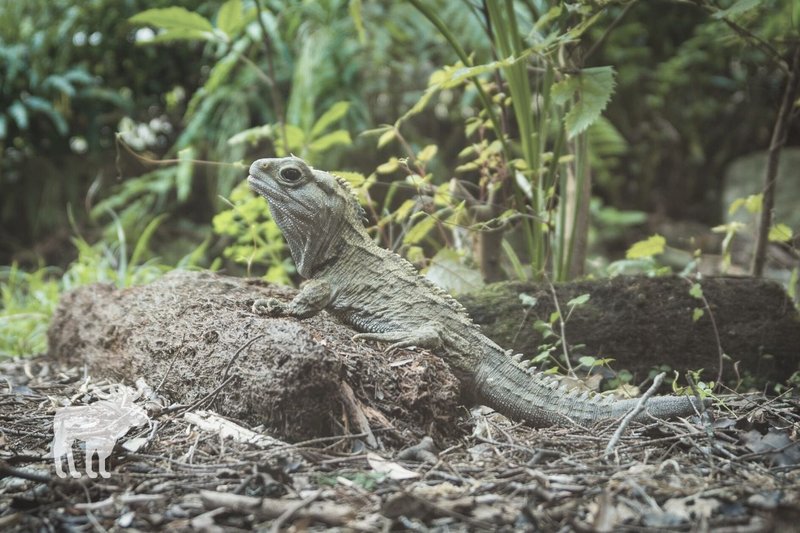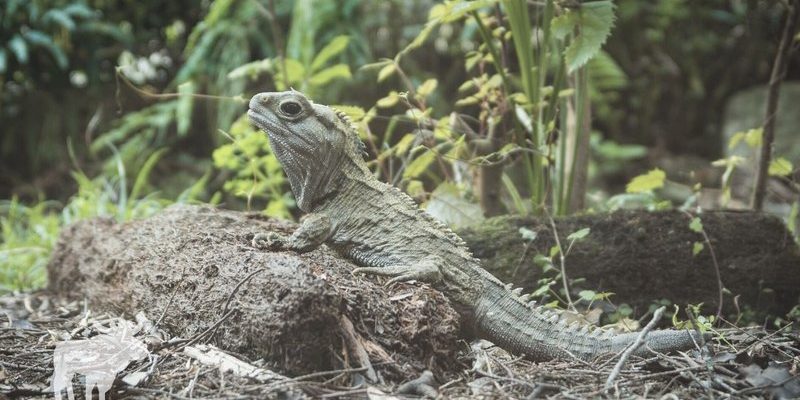
The tuatara is a truly fascinating creature that often leaves people scratching their heads. Imagine a reptile that looks somewhat like a lizard but is not quite one. It’s often called a “living fossil” because it has existed for over 200 million years, outliving the dinosaurs. This unique species is native to New Zealand and is the only surviving member of its order, Rhynchocephalia. While it might not be as widely known as other reptiles, the tuatara plays an important role in the ecosystem of its home islands.
Unlike most reptiles, tuataras have a distinctive feature: a third eye located on the top of their head, known as the parietal eye. Although this eye doesn’t see like the others, it helps regulate their circadian rhythms and hormone production. Picture this—while you and I rely on our two eyes to navigate the world, the tuatara has this extra, albeit quirky, eye keeping things in check!
In terms of appearance, tuataras have a robust body, spiky crests along their back, and a unique greenish-brown color that helps them blend into the forest floor. They can grow up to 80 centimeters (about 31 inches) long and live for over 100 years, making them one of the longest-living reptiles on Earth. Even more astonishing is their slow growth rate; they reach maturity at around 10 to 20 years old, which is quite unusual in the animal kingdom.
Interesting Facts About Tuataras
| Size: | Up to 80 cm (31 in) |
| Weight: | 1-2 kg (2.2-4.4 lbs) |
| Diet: | Insects, worms, small birds, and eggs |
| Speed: | Slow-moving, usually 0.5 to 1 km/h (0.3 to 0.6 mph) |
| Lifespan: | Over 100 years |
| Habitat: | Forests, coastal areas, and offshore islands |
Habitat and Distribution
You’ll find tuataras mainly on New Zealand’s offshore islands, where they thrive in lush, wooded areas. Their preferred habitats are usually free from predators like rats and cats, which can be quite harmful to them. Tuataras love to hide in burrows, crevices, or under rocks during the day and are most active during the cooler hours of dawn and dusk. Think of them as the original nighttime creatures, comfortably cozying up in their little homes while the sun is blazing down.
The environmental conditions that suit these reptiles include temperate climates with moderate humidity. Due to their sensitive nature, tuataras are vulnerable to changes in their habitat, making conservation efforts vital. Habitat destruction and the introduction of invasive species have put significant pressure on their populations, leading to strict protections under New Zealand law. In fact, several successful breeding programs and island restorations have been initiated to help increase their numbers.
Interestingly, tuataras can adapt to a range of environments, but they prefer areas where they can easily find food and shelter. This flexibility has allowed them to survive through various geological changes over millions of years. It’s almost like they’ve been honing their survival skills long before humans roamed the Earth!
Diet and Feeding Habits
When it comes to food, tuataras are not picky eaters, but their diet mainly consists of insects and small invertebrates. They particularly enjoy consuming crickets, beetles, and worms. However, if the opportunity arises, they won’t hesitate to munch on small birds and their eggs as well. Imagine a tiny dinosaur on the hunt, using its sharp teeth and powerful jaws to get the most out of its prey. Their specialized teeth, which are more like a beak, help them easily grasp and tear into food.
The tuatara has a slower metabolism compared to other reptiles, which means it doesn’t need to eat as often. They can go for months without a meal, especially in cooler months when food sources are scarce. This feature makes them very resilient. Picture yourself at a buffet, and instead, you decide to take your time to enjoy the feast—this is how a tuatara approaches its meals. They adapt their eating habits based on the available food, making them clever little survivors!
Tuataras are quite the strategic eaters. They often hunt at night, using their acute sense of hearing and eyesight to detect their prey in the dim light. You might think they rely solely on sight, but their senses work together like a finely tuned instrument, allowing them to locate food with impressive accuracy. So, next time you think of a night creature, remember the clever hunting tactics of this ancient reptile!
Reproduction and Lifespan
Reproduction in tuataras is a unique process. Unlike many reptiles, they don’t lay eggs every year. Instead, females only breed once every two to five years. They typically lay about 8 to 15 eggs in a burrow or sandy area, which she covers to protect from predators. Interestingly, the temperature of the environment determines the gender of the hatchlings. Warmer temperatures generally produce males, while cooler ones lead to females. How cool is that? It’s like Mother Nature’s own way of balancing the population!
The eggs take about 11 to 16 weeks to hatch, but it can vary depending on environmental conditions. Once hatched, the baby tuataras are completely on their own, venturing out into the wild without parental care. Imagine being a tiny tuatara, emerging from your safe little egg and having to navigate this vast world all by yourself. It must be a thrilling, if a little scary, beginning!
As for their lifespan, tuataras can live for more than a century. They grow extremely slowly, taking about 10 to 20 years to reach sexual maturity. This long life span and slow development mean they have fewer young over time, which can make their populations vulnerable to extinction. Conservation efforts are crucial for ensuring that future generations of tuataras thrive, allowing this remarkable species to continue its journey through time.
Conservation Status
The tuatara is listed as a vulnerable species, primarily due to habitat destruction, introduced predators, and a low reproductive rate. The presence of invasive species like rats and cats has further complicated their survival, leading to significant declines in their populations. It’s a bit disheartening to think about, but there are hopeful signs! Conservationists are actively working to protect tuataras through habitat restoration, population monitoring, and breeding programs.
By removing invasive species from islands and creating safe habitats, many tuatara populations are starting to thrive again. For instance, some islands have been cleared of predators, allowing tuataras to return and repopulate. It’s like giving them a second chance at life. Isn’t it inspiring to think about how these conservation efforts can help save such an ancient species?
Another initiative involves raising tuataras in captivity and then releasing them into their natural habitats. This helps increase their numbers and strengthen genetic diversity. As more people become aware of tuataras and their plight, support for conservation efforts continues to grow. By working together, we can help ensure that these remarkable creatures don’t just become a memory from the past.
FAQ
What do tuataras eat in the wild?
Tuatara mainly feed on insects, worms, and small invertebrates. Some of their preferred prey includes crickets and beetles, but they also have a taste for small birds and their eggs if they can find them. Their diet can vary based on available food sources, and they are known to hunt predominantly during the cooler evening hours.
Are tuataras dangerous to humans?
No, tuataras are not considered dangerous to humans. They are shy and tend to avoid interaction with people. Despite having sharp teeth, they are not aggressive and will usually flee if threatened. Tuataras are more interested in their natural habitat and finding food than causing harm to humans.
How do you tell the difference between male and female tuataras?
Male tuataras tend to be larger and have more robust heads compared to females. Additionally, males often have more pronounced spiky crests along their backs. However, the most definitive way to tell them apart is during the breeding season when males become more active and display courtship behaviors.
How can tuatara populations be protected?
Tuatara populations can be protected through habitat conservation, predator control, and breeding programs. Organizations are working diligently to remove invasive species from tuatara habitats and establish safe breeding sites. Raising tuataras in captivity and releasing them into the wild is also a key strategy to bolster their numbers.
Where can I see a tuatara in person?
If you’re eager to see a tuatara, various wildlife parks and zoos in New Zealand have them on display. Additionally, some special conservation areas and offshore islands allow for guided tours that include opportunities to observe these fascinating reptiles in their natural habitat.
What is the lifespan of a tuatara?
Tuatara are known for their impressive longevity; they can live for over 100 years. Their slow growth and late maturity mean they take a long time to reach adulthood, but this extended lifespan enables them to survive in their natural habitats for many decades.
Do tuataras need special care in captivity?
Yes, tuataras have specific care needs. In captivity, they require a suitable habitat that mimics their natural environment, including temperature control and appropriate humidity. They also have special dietary needs and should be housed in environments free from invasive species and potential predators.
Can tuataras regenerate lost limbs or tails?
No, unlike some reptiles that can regrow tails, tuataras do not have this ability. If they lose a tail or limb due to injury, they won’t be able to regenerate it. Instead, they rely on their ability to hide and escape predators to protect themselves.
What are the biggest threats to tuatara populations?
The primary threats to tuatara populations include habitat loss, introduced predators such as rats and cats, and climate change. These factors put substantial pressure on their numbers, making conservation efforts essential for their survival.
Why is the tuatara considered a living fossil?
The tuatara is called a living fossil because it shares many characteristics with reptiles that existed over 200 million years ago. It has survived numerous extinction events and has remained relatively unchanged over time, providing valuable insights into the evolutionary history of reptiles.
What role do tuataras play in their ecosystem?
Tuatara play an important role in their ecosystem as both predators and prey. By helping control insect populations and serving as a food source for larger predators, they contribute to the balance of their native habitats, making them a crucial part of New Zealand’s biodiversity.

